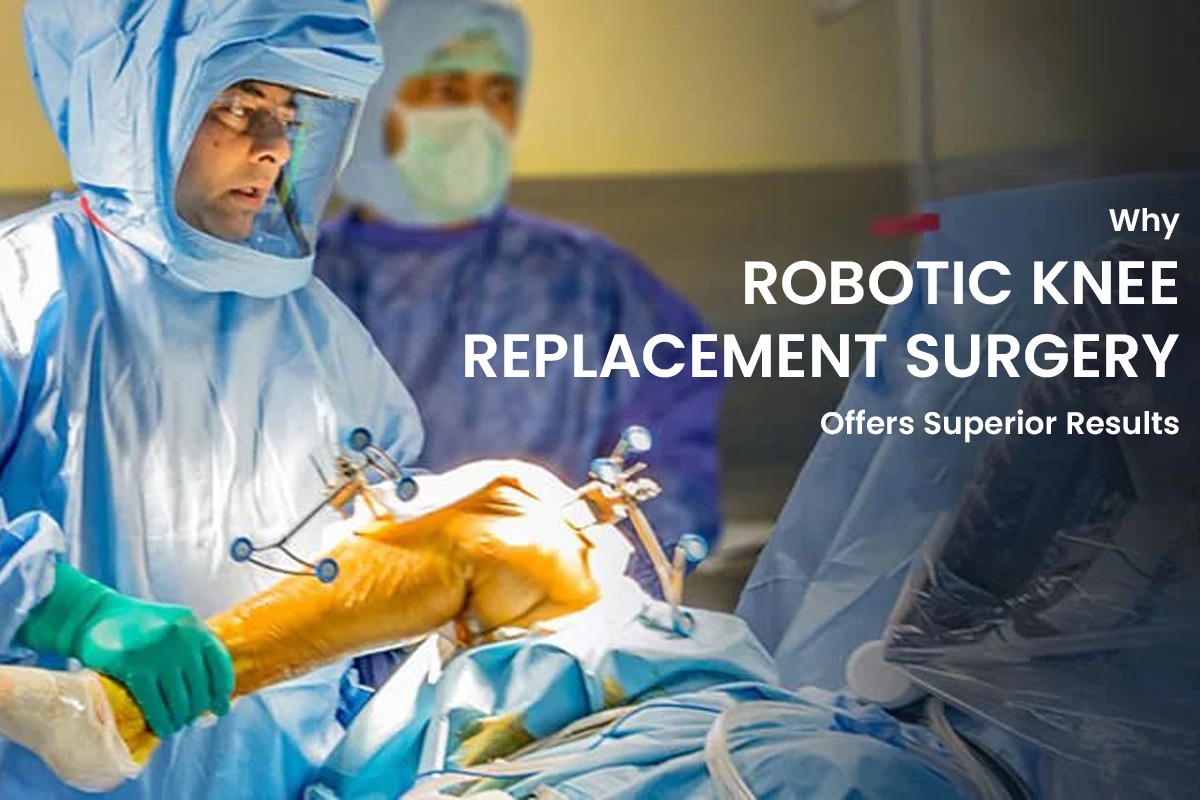Why Robotic Knee Replacement Surgery Offers Superior Results

The World Health Organisation (WHO) acknowledges robotic surgery as a growing trend in orthopedics, including knee replacements, due to its precision and potential benefits. Around the world, about three million knee surgeries happen each year. In 2020, robotic assistance was used in about 11% of these cases. Experts expect this number to grow, with robotic-assisted knee surgeries predicted to reach 700,000 by 2030. So, today we are here to share the same with you so that it can benefit you/ your dear ones who are facing knee issues.
Understanding Robotic Knee Replacement Surgery
This advanced surgery uses advanced robotic technology to assist surgeons in performing knee replacements with higher precision. In this method, the surgeon uses a tiny 3D camera and small surgical tools. They make small cuts, usually about 3 inches long. The camera gives a close-up view of the surgery. The surgeon controls robotic arms to handle the tools carefully. They remove the damaged part of the knee and put in a new implant. This lowers the risk of infection and helps patients recover faster. In layman’s language, if you cut a piece of wood exactly right using a robot, it fits perfectly. The same idea applies here for longer lasting Robotic knee replacement benefits.
Now we will explain you how this helps you in the long run and what all you need to be cautious about:
How Robotic Knee Replacement Surgery Performs Better Than Conventional Methods
Robotic knee replacement surgery performs better because the robot guides the doctor for precise cuts and fits. We are sharing the example of using a cookie cutter; the robot helps make perfect shapes. This accuracy means the Robotic knee replacement fits just right, like a puzzle piece fitting perfectly. For example, if you draw with a ruler, lines are straighter than drawing by hand. The robot acts like a ruler, making sure everything is exact. This leads to less pain, faster healing, and a knee that works well for a longer time compared to conventional methods where the fit might not be as perfect.
The Precision & Effectiveness Of Robotic Total Knee Replacement
Though we have already explained it above for the common man’s understanding, let us now share what doctors speak about it. In medical language: During the Robotic knee replacement surgery, the robotic system creates a detailed map of the knee. This allows surgeons to not only make exact cuts but also place the Robotic knee replacement perfectly. As a result, patients experience less pain, faster recovery that means longer lasting Robotic knee replacement benefits. This advanced technology ensures each knee replacement is tailored to the patient’s unique anatomy, thereby significantly ensuring happier Robotic knee replacement recovery time.
Who Needs Knee Replacement Surgery Procedures
People who need knee replacement surgery often have severe knee problems that affect their daily lives. And thes could be anyone from accident victims to orthopaedic patients:
- 1. Individuals with significant knee deformities causing pain and mobility issues may need Robotic knee replacement benefits.
- 2. Elderly individuals with worn-out knee cartilage called OsteoArthritis may struggle to walk or climb stairs due to pain and stiffness. They surely need after Robotic knee replacement care.
- 3. Then there are those with this autoimmune disease called Rheumatoid Arthritis who experience swollen, painful knees that limit movement. They benefit hugely from Robotic knee replacement surgery.
- 4. Robotic knee replacement benefits athletes or accident survivors with badly damaged knees might need surgery to restore function
What Happens if You Delay Robotic Knee Replacement Surgery
1. After Robotic knee replacement care may take longer. The recovery process may become longer and more challenging if the knee condition deteriorates further before surgery.
2. Delaying surgery may lead to progressive deterioration of the knee joint. This would limit your daily activities like walking or climbing stairs.
3. The condition causing the need for surgery, such as arthritis, can worsen over time, resulting in more pain and reduced mobility.
4. Severe arthritis or joint damage can cause deformities in the knee. This would be curbing down the Robotic knee replacement benefits which means making surgery more complex and less effective. This means longer Robotic knee replacement recovery time.
5. Prolonged delay increases the risk of complications during surgery and recovery, such as muscle weakness, stiffness, or difficulty regaining full function post-surgery.
6. Persistent pain and limited mobility can significantly impact overall quality of life. This will be affecting your independence and mental well-being.
Success rates of recovery after robotic knee replacement surgery
Indian and global success rates post robotic knee replacement surgery are promising. In India, success rates range around 90-95%, reflecting effective recovery and improved mobility. Globally, success rates are similarly high, averaging 85-90%. This data clearly underscores the overall effectiveness and efficiency of robotic-assisted techniques.
How Soon Can One Walk After Robotic Knee Surgery
Unless you have delayed the surgery by any chance, patients can typically begin walking soon after robotic knee surgery. Many are able to walk with assistance within 24 hours. Others can manage short distances without help. By the second week, patients often achieve greater independence in walking.
How Soon Can One Return to Normal Activities After Robotic Knee Surgery?
See here we would like to mention that there are various factors influencing this aspect that include:
— the patient’s overall health
— his/her adherence to rehabilitation protocols
— and the extent of knee damage prior to surgery
If you have reached your doctor at the right time, then After Robotic knee replacement care dips very low. This means quicker Robotic knee replacement recovery time and higher success rates. Yes, patients undergoing timely robotic knee surgery often experience accelerated recovery timelines. Within weeks, many regain the ability to perform daily activities such as walking, climbing stairs, and light household chores. Studies show that approximately 90% of patients resume normal activities within 6 weeks post-surgery.
So what are you waiting for? If you or anyone you know is having knee discomfort, then choose robotic knee replacement surgery for quicker recovery. We assure you that you will experience fewer risks and better long-term results. Consult with your orthopedic specialist today to learn how robotic surgery can improve your knee health and quality of life.






